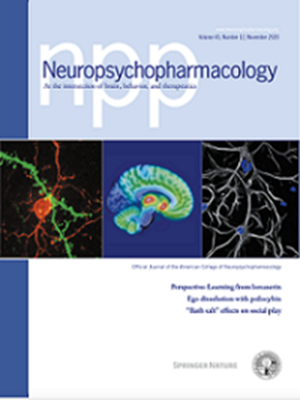Prefrontal cortex excitatory neurons show distinct response to heroin-associated cue and social stimulus after prolonged heroin abstinence in mice
IF 6.6
1区 医学
Q1 NEUROSCIENCES
引用次数: 0
Abstract
Substance use disorder (SUD) has been linked with social impairments. The social cognitive dysfunctions can further increase the risk of the development of SUD or relapse. Therefore, understanding the neural mechanism of substance exposure-associated social impairments is beneficial for the development of novel prevention or treatment strategies for SUD. The prefrontal cortex (PFC) is a key brain region involved in both social cognition and drug addiction. Specifically, the prelimbic part of PFC (PrL) regulates social interaction and heroin-seeking behavior. Therefore, in this study, we explored how PFC excitatory neurons respond to social stimuli after prolonged abstinence from heroin self-administration (SA). Using fiber photometry calcium imaging, we monitored calcium-dependent fluorescent signals in PrL CaMKII-expressing neurons during drug seeking and social interaction tests following 14 days of abstinence from heroin SA. We found that GCaMP6f signals in PrL CaMKII-expressing neurons were increased when heroin-associated cues were presented during drug-seeking tests in both male and female mice after prolonged heroin abstinence, although the baseline neuronal activity in home cage is lower in the heroin group. Conversely, the calcium signals in PrL CaMKII-expressing neurons during social investigation were decreased after heroin abstinence in both sexes, along with reduced total social interaction time. In addition, drug-seeking behavior is partially negatively correlated with social investigation time. These findings provide direct evidence showing that opioid exposure impairs the PFC functional response to social stimuli, which may potentially increase the risk for opioid relapse.

小鼠长期戒断海洛因后,前额叶皮层兴奋性神经元对海洛因相关线索和社会刺激表现出明显的反应。
物质使用障碍(SUD)与社会障碍有关。社会认知功能障碍可进一步增加SUD发展或复发的风险。因此,了解物质暴露相关社会障碍的神经机制有助于开发新的预防或治疗策略。前额叶皮层(PFC)是参与社会认知和药物成瘾的关键脑区。具体来说,PFC的前边缘部分(PrL)调节社会互动和海洛因寻求行为。因此,在本研究中,我们探讨了长时间戒断海洛因自我给药(SA)后PFC兴奋性神经元对社会刺激的反应。在戒除海洛因SA 14天后,在药物寻求和社会互动测试中,我们使用纤维光度钙成像技术监测了PrL camkii表达神经元中钙依赖的荧光信号。我们发现,在长时间的海洛因戒断后,雄性和雌性小鼠在药物寻找测试中出现与海洛因相关的线索时,PrL camkii表达神经元中的GCaMP6f信号增加,尽管在家笼中海洛因组的基线神经元活动较低。相反,戒断海洛因后,两性社会调查过程中PrL camkii表达神经元的钙信号减少,总社会互动时间减少。此外,吸毒行为与社会调查时间呈部分负相关。这些发现提供了直接证据,表明阿片类药物暴露会损害PFC对社会刺激的功能反应,这可能会增加阿片类药物复发的风险。
本文章由计算机程序翻译,如有差异,请以英文原文为准。
求助全文
约1分钟内获得全文
求助全文
来源期刊

Neuropsychopharmacology
医学-精神病学
CiteScore
15.00
自引率
2.60%
发文量
240
审稿时长
2 months
期刊介绍:
Neuropsychopharmacology is a reputable international scientific journal that serves as the official publication of the American College of Neuropsychopharmacology (ACNP). The journal's primary focus is on research that enhances our knowledge of the brain and behavior, with a particular emphasis on the molecular, cellular, physiological, and psychological aspects of substances that affect the central nervous system (CNS). It also aims to identify new molecular targets for the development of future drugs.
The journal prioritizes original research reports, but it also welcomes mini-reviews and perspectives, which are often solicited by the editorial office. These types of articles provide valuable insights and syntheses of current research trends and future directions in the field of neuroscience and pharmacology.
 求助内容:
求助内容: 应助结果提醒方式:
应助结果提醒方式:


